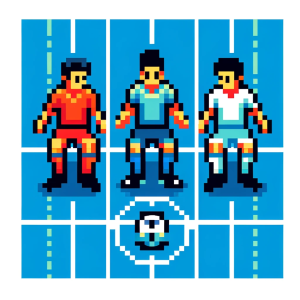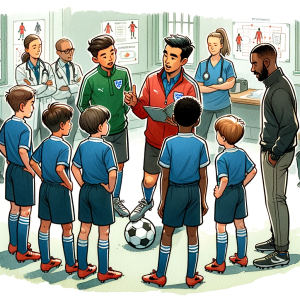
Building Positive Soccer Environments: A Coach’s Guide to Success
When it comes to soccer, the winning formula often extends beyond what happens on the field. Whether you’re an experienced coach or just starting out, one key to your team’s success isn’t found in strategy books or training drills—it’s in the environment you create. Research shows that a positive soccer environment directly impacts player development, mental health, and overall team performance. But what exactly is a “positive environment,” and how can you make it a reality for your players?
In this post, we’ll explore actionable strategies to build a positive soccer environment that not only helps your players thrive but also strengthens your coaching impact. This guide offers a roadmap to ensuring that your players feel safe, supported, and motivated to succeed, both on and off the field.
What is a Positive Soccer Environment?
Imagine stepping onto a field where every player feels valued, mistakes are treated as learning opportunities, and effort is celebrated over results. A positive soccer environment does just that—it emphasizes safety, trust, and the holistic development of each athlete. But it goes even deeper, affecting how athletes approach challenges, collaborate with teammates, and grow emotionally. Coaches play a pivotal role in shaping this environment, and their actions can have long-lasting impacts on their players’ lives.
The Coach’s Role: Creating Trust and Emotional Safety
As a coach, you hold the keys to unlocking your players’ full potential. But it’s not just about knowing the game; it’s about understanding how to communicate, how to lead, and how to foster relationships that build trust. The toolkit from the (Creating Positive Socce…) highlights some essential steps every coach can take to establish a positive atmosphere:
- Learn Your Players’ Names: This simple gesture shows you care about them as individuals. Use their preferred names and make a point to connect with each athlete on a personal level.
- Give Positive, Specific Feedback: Research reveals that the tone, content, and amount of feedback you provide can alter how athletes perform and develop both mentally and physically. For example, instead of saying, “You need to work on your passing,” try, “I noticed your passing is improving. Next time, try using your left foot to open up more options.”
- Recognize Effort Over Results: By praising effort, you inspire a growth mindset in your players. Reframing mistakes as learning opportunities helps them view challenges as part of the journey rather than as failures.
Filling Emotional Tanks: The Key to Player Motivation
Soccer isn’t just a physical game; it’s an emotional one. Players come to practice and games with “emotional tanks” that can either be filled or drained by their experiences. Coaches have the unique power to fill these tanks, fostering an environment where players feel encouraged, supported, and ready to give their best.
One powerful tool is the Magic Ratio: For every criticism, aim to give five positive affirmations. This strengthens relationships and makes players more open to feedback. Another effective strategy is Feed-Forward Coaching. Instead of focusing on what went wrong, guide players toward what they can improve next time. For example, saying, “Next time, try to angle your body differently when receiving the ball,” helps players focus on the future, not their past mistakes.
Building Team Camaraderie: From Solo Players to United Teams
One of the most rewarding aspects of soccer is the team dynamic. Players need to trust each other, work together, and share common goals. As a coach, you can encourage this unity through simple yet effective, techniques:
- Team-Building Activities: Start practice or a season with activities that help players find common ground. These activities promote interaction, build trust, and encourage collaboration. For example, small group challenges can boost communication and camaraderie.
- Buddy System: Pair players or create small groups where teammates provide support and encouragement to one another. This not only builds relationships but also ensures every player feels included.
- Team Rituals: Team rituals, whether a cheer, a shared gesture, or a post-game tradition, can build a sense of belonging and unity. Encourage your players to create their own, whether it’s “flushing” mistakes with a hand gesture or celebrating every small success with a high five.
Communication and Leadership: The Building Blocks of Respect
Your communication style is as important as the words you say. Nonverbal cues, tone of voice, and body language can have a profound effect on how your players receive information. In a positive soccer environment, it’s essential to communicate with respect and empathy.
For instance, when providing criticism, choose your timing carefully. Right after a mistake might not be the best time, as the player may still be emotionally processing what happened. Instead, ask permission to offer feedback, which empowers the player to receive it when they’re ready. Say, “I noticed something that might improve your shooting. Are you open to hearing it?”
Leadership also plays a role in setting the tone for the team. Model the behaviors you want to see—stay calm under pressure, be enthusiastic, and show that you value every player’s contribution. By leading with empathy, you build a team that mirrors your actions.
The Ripple Effect: Impacting Players On and Off the Field
The effects of a positive soccer environment stretch far beyond the field. Players who feel supported and safe are more likely to take on challenges, engage in learning, and develop resilience. They perform better not just in games but in life. When you focus on building relationships and fostering emotional safety, you’re not just coaching players—you’re mentoring future leaders.
Studies also show that players in positive environments experience improved mental health and are less likely to drop out of sports altogether. They’re more motivated to come to practice, to put in the hard work, and to stick with soccer, even through tough times.
Join the Conversation
What have you found to be the most effective ways to build trust and camaraderie within your team? How do you ensure your players feel emotionally supported during tough moments? Share your thoughts in the comments below, and let’s learn from each other’s experiences.
Are you ready to delve deeper into the science and strategy of soccer?
This Week in Soccer offers you a unique blend of expert analysis, engaging infographics, and practical insights. Subscribe to our newsletter and stay ahead of the game with the latest in soccer analytics and coaching strategies. Make the move from spectator to strategist. Subscribe now!


